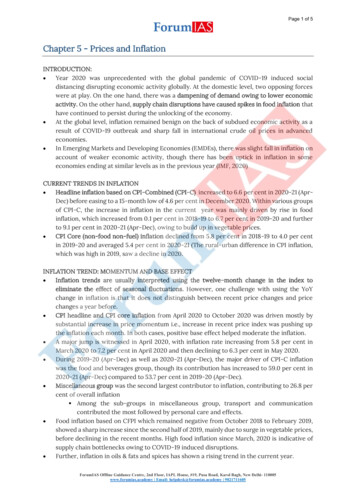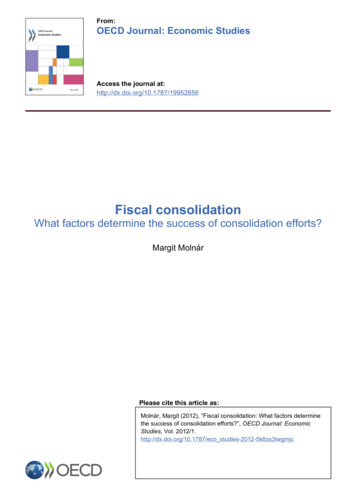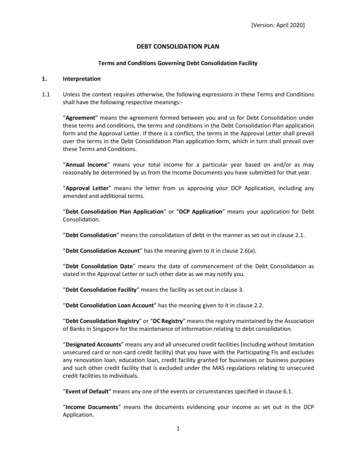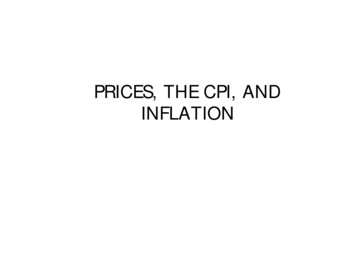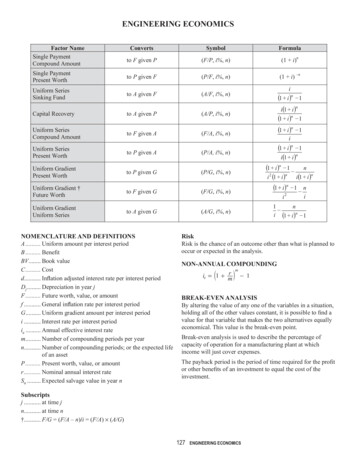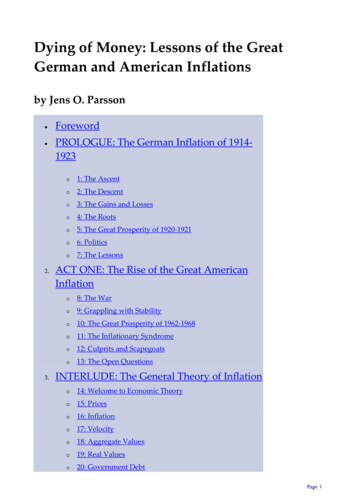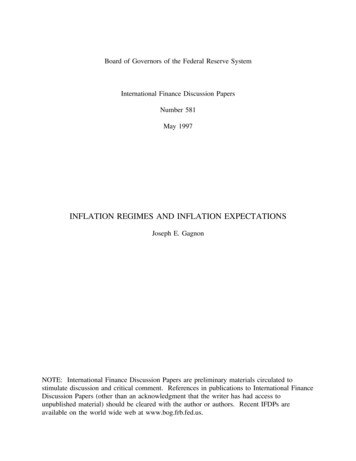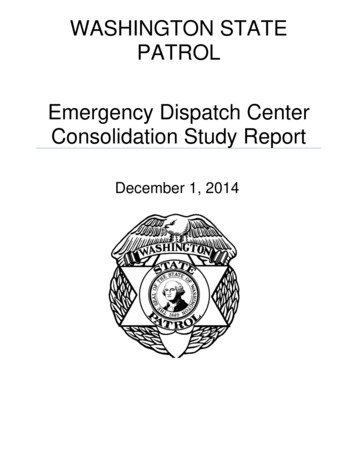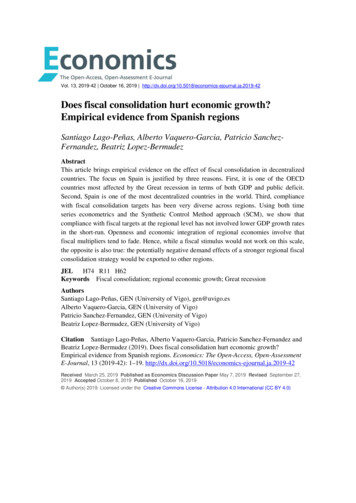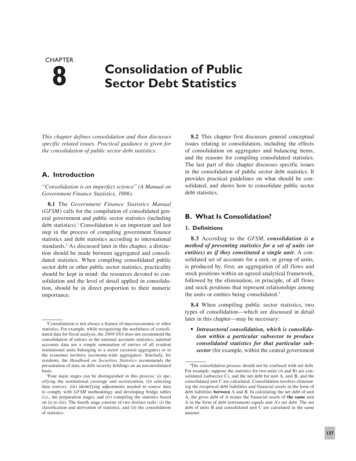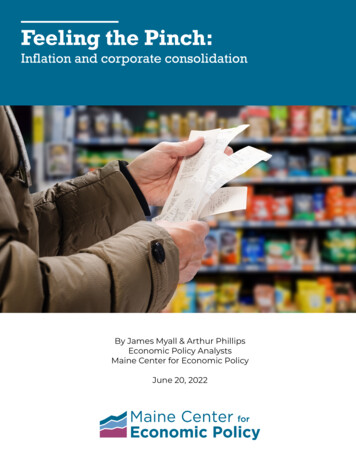
Transcription
Feeling the Pinch:Inflation and corporate consolidationBy James Myall & Arthur PhillipsEconomic Policy AnalystsMaine Center for Economic PolicyJune 20, 2022
Feeling the PinchIntroductionPrices are rising and Mainers are feeling the pinch.At the same time, some of the world’s largestcorporations are reporting record profits.The mismatch between Mainers feeling the pinch ascorporate profits rise is the result of choices madeby policymakers over time, particularly at the federallevel, that have given corporations greater powerover people to set prices and control the flow ofgoods and services. Now, corporations are using thispower to extract even larger profits under the coverof current global supply chain disruptions.Prices on everyday items that we all rely on includingmeat, milk, bread, fuel, and electricity have goneup as much as 16 percent in the last year.1 That’s well above the average increase in the costs of goods andservices as a consequence of the economic impacts of the COVID-19 pandemic, Russia’s invasion of Ukraine,and changing consumer behavior. From April 2020 through December 2021, corporate profits accounted for54 percent of each dollar increase in prices compared to just 11 percent on average during the 40 years priorto that period. As a result, corporate profits are the highest they’ve ever been since the late 1940s.Against this backdrop, policymakers must work to reduce corporate consolidation and power while alsohelping to buttress Mainers against ongoing price increases.Mainers feel the pain of rising pricesA rapid increase in prices of essential goods and services can stretch any household budgetand is especially painful for people with low incomes who are often already living paycheck-topaycheck. Before the pandemic, nearly half of Mainers were unable to cover a surprise expenseas small as 400 without taking on some debt.2 When the price of essentials such as groceries,gas, and rent increase rapidly, many families can easily be thrown into financial crisis.For some families the impact of rising prices has been lessened somewhat by rising wages,especially in certain sectors of the economy. For example, as of April 2022, average hourly wagesfor leisure and hospitality workers in Maine were 13.2 percent higher than a year before. Payin these sectors outstripped inflation, which rose at 8.5 percent over the year, leaving workerswith more money in their pockets even with higher prices.3However, many workers as well as Mainers on fixed incomes have seen a decline in their abilityto cover higher costs. The average hourly wage for all private sector workers has increased just7.5 percent over the past year,4 and while Social Security recipients received a 5.9 percent costof living adjustment in January, prices have since outpaced that increase.Page 2 Maine Center for Economic Policy
Feeling the PinchPrice increases are greatest wherecorporations have the most powerOver the past three decades, there has been aconsistent consolidation of market power, with asmall number of corporations controlling most of themarket for a particular product.5 While some amountof consolidation can bring benefits to consumers, aslarger companies are able to achieve savings throughefficiency of scale, excessive consolidation reducescompetition and makes it easier for companies tocharge excessive prices.Studies have shown that since 1980, companiescharging higher markups and collecting larger profitshave come to dominate many industries, leadingto higher average prices for customers.6 A studypublished by the Federal Reserve Bank of Bostonfound the widespread economic concentration theUS economy has undergone since 2005 resulted ina 25 percent increase in producer’s ability to passcosts onto consumers.7 Other research confirmsthat increased competition helps reduce inflation,and concentration of market power among just a fewfirms increases it.8Some of the sectors which currently have the highestrate of growth in prices also have the highest rates ofmarket concentration:Gas. A 2004 report by the US GovernmentAccountability Office showed that rapid consolidationof the US petroleum market in the 1990s did indeedlead to price increases at the pump.9 Over the pastyear, gas prices in Maine have risen 59 percent.10These price increases have continued even aftercrude oil prices declined. For example, crude oilprices peaked on March 8 at 124 a barrel. Sincethen, the price of crude has declined by 5 percent,but the price of gas in Maine has increased 18percent.11Food. Just four firms control more than half of themeat-processing industry.12 Over the past year, theprice of meat has risen 12.3 percent. Other commongrocery items are also only produced by a smallnumber of large corporations.13Page 3 Maine Center for Economic PolicyIncreased competition helps reduceinflation. Concentration of market poweramong just a few firms increases it. Three corporations produce 73 percent of allbreakfast cereals, the price of which has risen12.1 percent in the past year. Four corporations sell 61 percent of all the breadin the United States, the price of which has risen8.7 percent. Consolidation, especially at the regional level, inthe dairy industry has led to many small farmsgoing out of business because the large firms canset prices for raw milk especially low.14 However,consumers are currently paying very high pricesfor milk at the store – up 15.9 percent over theyear.Electricity. Mainers have very few options forpurchasing electricity. Transmission and deliverycosts are essentially set by the single providerservicing their home. And while there is somecompetition in the “supply” component of electricitybills, just 10 percent of Mainers use competitiveenergy providers.15 The vast majority receive the“standard offer” price through Central Maine Poweror Versant Energy. Nationally, electricity costs haverisen 12 percent over the past year.
Feeling the PinchCorporations are reporting recordprofits – and still raising pricesIf we look closely at sectors where prices mostsignificantly impact household costs, we can seehow firms in consolidated industries have operatedduring this period of heightened inflation. Forexample, consolidated firms in the food processingand energy sectors have dramatically raised theirprices while reaping historic profit margins.Consolidated firms in the foodprocessing and energy sectors havedramatically raised their prices whilereaping historic profit margins.In 2021, corporate profits were the highest they’vebeen since the late 1940s.16Despite the adversity being faced by hardworkingfamilies as a result of the economic disruptioncaused by COVID-19 and other global events,corporations continue to extract greater profits.An analysis of financial filings of the top 100 USCorporations by The Guardian found median profitswere up by 49 percent compared to before thepandemic, while median wages only increased by 1.6percent over the same period.17Analysis by the Economic Policy Institute (EPI)found a similar trend. During the period from April2020 through December 2021, in the nonfinancialcorporate sector, for every dollar in price increases,54 cents went toward corporate profits, while just 8cents went to increased wages.18These figures are far from the norm — they’re upsidedown. According to EPI, from 1979 to 2019, profitscontributed about 11 percent to price growth whilelabor costs contributed more than 60 percent.19Page 4 Maine Center for Economic PolicyAccording to the National Economic Council, thefour biggest companies in the highly concentratedmeat-processing industry reported in late 2021that their gross profits had increased by more than120 percent compared to before the pandemic.20They also collectively spent at least 4 billion onstock buybacks and dividends to shareholders.Meanwhile, from December 2020 to December 2021,the price of meat, poultry, fish, and eggs increasedby 12.5 percent, a leading driver in the rising cost ofgroceries.21Tyson Foods is one of the world’s largest meatprocessing firms and has a production facility inPortland, Maine. The company saw shares reach arecord high this year after reporting first-quarterprofits had nearly doubled.22 Tyson raised its beefprices by an average of 31.7 percent in the quarterending January 1 and raised prices of all its productsby an average of 19.6 percent.Hormel Foods, another leading food processingcorporation, announced that due in part to its pricingpower — the company’s ability to raise prices withoutlosing market share — the company’s operatingincome rose by 19 percent in the first quarter of2022 compared to the same period a year earlier.Yet CEO Jim Snee told investors the company wasimplementing another round of price increases forits grocery products.23Another sector reaping historic profits as pricesfor consumers have skyrocketed is the oil industry.Russia’s invasion of Ukraine in February andsubsequent sanctions have curtailed the supply ofoil and capacity to refine it into gasoline. However, oilcompanies were reporting record profits before the
Figure 1: Corporate profits used to account for a small portion of price increases.Recently, they’ve represented the majority.SOURCE: MECEP analysis of Economic Policy Institute datainvasion and have rebuffed calls to increase supply. US households that remain dependent on oil for heatingand transport, including many in the cold, rural state of Maine, have meanwhile faced sharply higher prices.Chevron CEO Mike Wirth told investors during the company’s 2021 Q4 earnings call, “the last two quartershave been the best two quarters the company has ever seen. And last year was 25 percent higher than thebest year in our history.”24Exxon reported first quarter profits in 2022 of 5.5 billion, double its earnings from the same period the yearbefore. The company also announced it would triple stock buybacks from 10 billion to 30 billion through2023.25At a time when many workers and families face increased struggles to make ends meet, the profits ofpowerful corporations are soaring and prices continue to rise. This disparity illustrates an economic systemthat enables corporate giants to take advantage of circumstances to keep prices high and bottom linesrobust — all at the expense of everyday people.Page 5 Maine Center for Economic Policy
Feeling the PinchPolicymakers can reign incorporate power and reduce thepain caused by rising pricesfor federal action. The Maine Attorney General canuse their own authority to investigate and pursuecorporations for violations of antitrust law.27Similarly, Maine has several regulatory agencieswhich can more actively restrain corporationsseeking excessive price increases. The Maine PublicUtilities Commission (MPUC) is charged with ensuringcompanies such as Central Maine Power and VersantEnergy do not impose unreasonable price hikes ontheir captive customers. Yet MPUC regularly approvessignificant rate increases, most recently boosting thecost of electricity supply by more than 80 percent for2022.28Lawmakers must act to protect the mostvulnerable Mainers while taking oncorporate giants whose profiteering ismaking people’s struggles worse.Regulators must take a new approach toantitrust lawsFederal and state regulators can play a key rolein preventing excessive concentration of marketpower — which allows for higher prices and lack ofcompetition. The US Department of Justice (DOJ) andFederal Trade Commission (FTC) are responsible forapproving corporate mergers in the United States andenforcing antitrust laws. Yet for decades the federalgovernment has retreated from its role in ensuringmarkets are competitive.Since the late 1970s, the federal government has beenincreasingly reluctant to bring antitrust cases againstcorporations, and the FTC has routinely approvedeven the largest corporate mergers.26 The DOJ andFTC need to recognize the harm done by excessivemarket concentration and step up enforcementappropriately. Moreover, Maine does not have to waitPage 6 Maine Center for Economic PolicyThe state’s ability to control health care costs issomewhat limited by the complexity of the health caremarket, but the State Bureau of Insurance can rejectexcessive health insurance rate increase requestsfrom some providers, and the newly established Officeof Health Care Affordability has a mandate to findways to reduce costs through greater state regulationand oversight.Governor Mills has the power to tackleprice gouging directlyPolicymakers could also tackle corporate ‘profiteering’— the leveraging of circumstances to raise excessiveprofits — head-on. Maine law allows the governor toprevent price gouging during a period of “abnormalmarket disruption” for a specified commodity. Underthe law, businesses cannot raise prices by morethan 15 percent above their previous prices (afteraccounting for increased input costs).29 This law wasinvoked at the start of the COVID-19 pandemic buthas since lapsed. Reinstating a market disruptionproclamation would reduce instances of profiteeringand price gouging. While it’s not immediately clearhow many companies would be constrained by thisrule in Maine, recent national data on corporate
profits shows that average aggregate profit marginsfor corporations have been close to 15 percent for thepast year.30A windfall tax could redirect profits tostruggling MainersAnother tool to address profiteering would be theadoption of a one-time “excess profits” or “windfall”tax. Businesses would pay a special high rate of taxon any additional profits above their 2019 levels.Such taxes have been adopted as extraordinarymeasures before. The United States had a widespread95 percent excess profits tax during World War II toprevent war profiteering and implemented a moretargeted windfall tax against oil companies in the1980s.31 Recently, the Conservative government inthe United Kingdom has announced its own windfalltax on energy companies, with the proceeds payingfor assistance to struggling Britons.32 Reinstating sucha tax at the state or federal level would remove theincentive for corporations to profit at the expense ofsuffering Mainers.Robust safety net programs can mitigatehardships caused by rising pricesAside from these direct actions, lawmakers have toolsto reduce suffering in the short term. and to bringdown prices in particular areas in the medium term.Maine’s recent initiative to issue 850 checks tomost adults will provide some immediate reliefto families facing increased costs. However, thisprogram is expensive — around 730 million dollars— representing 15 percent of general revenues thisyear33 and is unlikely to be repeated on this scale. It isalso not well-targeted to people struggling to affordhigher costs of the basics, since couples making up to 200,000 could receive a payment of 1,700.34To ensure the most vulnerable Mainers are protectedfrom the impacts of rising prices, lawmakers shouldstrengthen existing safety net programs: The Supplemental Nutrition Assistance Program(SNAP) helps families with low income purchasefood. The federal government is temporarilyallowing states to issue the maximum possibleSNAP benefit to families. Maine should continueapplying for this maximum assistance as long aspossible. The Temporary Assistance for Needy FamiliesPage 7 Maine Center for Economic Policy(TANF) program provides a cash benefit to thepoorest families. Thanks to recent improvementsto the program, the monthly TANF benefitincreases each year to keep up with inflation.However, the program is still under-utilized,and Maine has accrued a substantial balance ofunspent funds.35 In this time of acute need, Maineshould ensure as many eligible people as possiblemake use of this extra support. The Low Income Home Energy Assistance Program(LIHEAP) provides assistance to Mainers facingdifficulty heating their homes. However, helpdoesn’t reach everyone who needs it becausethere aren’t enough staff to process applications.36Again, the state should streamline administrationof the program to increase access and raiseawareness so that all eligible Mainers know toapply.Long-term policy changes are needed tocurb future price increasesFor longer-term solutions to bring down the costof living, lawmakers need to look at investments inprograms to reduce key costs: Many state tax expenditure programs implicitlyencourage corporate consolidation by favoringlarge companies over small businesses in severalways. Tax breaks generally scale with the sizeof the business, providing a bigger break to thelargest corporations — for example, in Maine’sBusiness Equipment Tax Reimbursement (BETR)program, 46 percent of the benefit goes to thelargest 1 percent of applicants.37 Some tax benefitsare only available to companies over a certain sizethreshold — for example, the outcomes in therecent Paycheck Protection Program showed howsmall firms can be excluded because they don’thave the same capacity to apply for governmentassistance as their large competitors.38Maine must stop effectively subsidizing marketconsolidation with many of these programs.Reforming or eliminating wasteful and costly taxbreaks for corporations will end this incentive toconsolidate and free up state revenue to helpconsumers. Close to 94,000 Mainers have already beeninsulated from rising health care costs by theexpansion of eligibility for MaineCare, the state’sMedicaid program.39 The legislature has built on
this success by extending coverage for thousands more children with low income and women followingchildbirth.40 Maine has also taken small steps toward regulating the price of prescription drugs. Doing somore aggressively would produce real savings for most Mainers. At the federal level, Congress authorizedadditional subsidies for people purchasing individual insurance under the Affordable Care Act, from which66,000 Mainers currently benefit.41 Congress must extend these subsidies to ensure premiums don’t rise forthese people. Maine should build on the recently passed wage subsidies for child care providers which will reduce theneed for care centers to increase tuition and will help retain staff. The state or federal government couldalso implement a subsidy for parents to make it easier to afford care. A recent federal proposal would havecapped costs at a share of parents’ income up to 7 percent. Affordable housing remains an acute challenge in Maine. The recent passage of statewide zoning reformwill gradually increase the supply of housing and bring prices down. There are additional steps which can betaken, including a state housing voucher program, construction of public housing, and stricter regulation ofshort-term rentals which take housing away from Mainers.An acute problem requires decisive leadershipThe rapid increase in the cost of living is clearly hitting many Mainers hard, especially those with low income.In the early months of the pandemic, lawmakers took decisive action to address the public health crisis andunprecedented economic fallout that resulted. Now, more than two years after the outbreak of COVID-19 inthe United States, similar leadership is required to take on both the causes and impacts of inflation. Lawmakersmust act to protect the most vulnerable Mainers while taking on corporate giants whose profiteering is makingpeople’s struggles worse.About MECEPThe Maine Center for Economic Policy is a nonprofit research and policy organization dedicatedto economic justice and shared prosperity by improving the well-being of Mainers with low andmoderate income. Since its founding in 1994, MECEP has provided policymakers, advocates,media organizations, and the public with credible, rigorous research and analysis. MECEP is anindependent, nonpartisan organization.About the authorsJames Myall is MECEP’s lead on labor and workforce issues and education and health care policy.He conducts research and impact analyses, writes educational materials, and collaborates withpartners. James is skilled in data collection, research, and statistical and policy analysis. He has amaster’s degree in public policy and management from the University of Southern Maine and amaster’s degree in ancient history and archaeology from the University of St. Andrews in Scotland.Myall is a member of Maine’s Permanent Commission on the Status of Racial, Indigenous, andMaine Tribal Populations and was a member of the Governor’s Economic Recovery Committee.Arthur Phillips works on MECEP’s inclusive economy portfolio and leads outreach and advocacyon labor issues. Phillips worked for seven years as a researcher and campaign strategist with thehospitality workers’ union UNITE HERE. Before that, he conducted research published by theEconomic Policy Institute and the Center for Economic and Policy Research in Washington, DC.He holds a bachelor’s degree in history with a minor in economics from McGill University.Page 8 Maine Center for Economic Policy
Endnotes1 Unless otherwise noted, all figures for inflation in this piece are those from the US Bureau of Labor Statistics,Consumer Price Index for all Urban Consumers (CPI-U) as of April 2022.2 Myall, James, “Could you cover an unexpected 400 expense? Nearly half of all Mainers could not.” Maine Centerfor Economic Policy, June 26, 208.3 BLS small area employment data, April 2022 annual change (preliminary estimate as of June 13, 2022)4 BLS small area employment data, April 2022 annual change (preliminary estimate as of June 13, 2022)5 Davis, Leila and Özgür Orhangazi, “Competition and monopoly in the U.S. economy: What do the industrialconcentration data show?” Competition and Change 2021, vol 25(1), pp3-20. and White, Lawrence J., and JasperYang, “What Has Been Happening to Aggregate Concentration in the U.S. Economy in the 21st Century?” SocialScholars Research Network, Apr 18, 2017.6 De Loecker, Jan, Jan Eeckhout and Gabriel Unger, “The Rise of Market Power and the MacroeconomicImplications,” Nov 15, 2019.7 Bräuning, Falk, José L. Fillat and Gustavo Joaquim, “Cost-Price Relationships in a Concentrated Economy,” FederalReserve Bank of Boston, May 23, 2022.8 Przybyla, Marcin, and Moreno Roma, “Does Product Market Competition Reduce Inflation? Evidence From EUCountries and Sectors,” European Central Bank, March 2005.9 US Government Accountability Office “Energy Markets: Effects of Mergers and Market Concentration in the U.S.Petroleum Industry,” May 17, 2004.10 From 2.98 per gallon on May 20, 2021 to 5.03 per gallon on June 7, 2022. Data from gasbuddy.com.11 Price of West Texas Intermediate crude oil from St Louis Federal Reserve. Price of regular gasoline in Mainefrom Gasbuddy.com. Prices as of June 6, 2022.12 Data from Open Markets Institute13 Lakhani, Nina, Aliya Uteuova and Alan Chang, “Revealed: the true extent of America’s food monopolies, andwho pays the price.” The Guardian, July 14, 2021.14 Appelbaum, Eileen, and Jared Gaby-Biegle, “Spilt Milk: COVID-19 and the Dangers of Dairy IndustryConsolidation,” Center for Economic and Policy Research, Aug 15, 2020.15 Maine Public Utilities Commission data.16 Owens, Jeremy C., “Corporate profit is at a level well beyond what we have ever seen, and it’s expected to keepgrowing,” Marketwatch, Apr 14, 2022.17 Perkins, Tom, “Revealed: top US corporations raising prices on Americans even as profits surge,” The Guardian,Apr 27, 2022.18 Bivens, Josh, “Corporate profits have contributed disproportionately to inflation. How should policymakersrespond?” Economic Policy Institute, Apr 21, 2022.19 Ibid.20 Deese, Brian, Sameera Fazili, and Bharat Ramamurti, “Recent Data Show Dominant Meat Processing CompaniesAre Taking Advantage of Market Power to Raise Prices and Grow Profit Margins,” The White House, Dec 10, 2021.21 US Bureau of Labor Statistics, Consumer Price Index, year-over-year change as of Dec 2021.22 Polansek, Tom, and Ananya Mariam Rajesh, “Tyson Foods shares set record as high meat prices fatten profits,”Reuters, Feb 7, 2022.23 The Motley Fool, “Hormel Foods Corporation (HRL) Q4 2021 Earnings Call Transcript,” Dec 9, 2021.24 The Motley Fool, “Chevron (CVX) Q4 2021 Earnings Call Transcript,” Jan 28, 2022.25 The Motley Fool, “ExxonMobil (XOM) Q1 2022 Earnings Call Transcript (HRL)” Apr 29, 2022.26 Stucke, Maurice, and Ariel Ezrachi, “The Rise, Fall, and Rebirth of the U.S. Antitrust Movement,” HarvardBusiness Review, Dec 15, 2017, and Baker, Jonathan, “Market power in the U.S. economy today,” Washington Centerfor Equitable Growth, Mar 20, 2017.27 Knox, Ron, “Fighting Monopoly Power: State Attorneys General,” Institute for Local Self Reliance. Accessed June13, 2022.Page 9 Maine Center for Economic Policy
28 Popp, Evan, “CMP, Versant ratepayers struggle to weather cost of higher electricity bills,” Maine Beacon, Mar 9,2022.29 Maine Revised Statutes as Amended, Title 10, §1105.30 St Louis Federal Reserve data, Profit per unit of real gross value added of nonfinancial corporate business:Corporate profits after tax with IVA and CCAdj (unit profits from current production).31 Avi-Yonah, Reuvan, “Time to Tax Excessive Corporate Profits,” The American Prospect, Apr 18, 2022.32 Her Majesty’s Treasury (United Kingdom), “Energy Profits Levy Factsheet - 26 May 2022,”33 Maine Revenue Forecasting Committee, March 2022 Report.34 Office of Governor Janet T. Mills, “Relief Checks.” Accessed June 13, 2022.35 Center on Budget And Policy Priorities, “Maine TANF Spending,” Accessed June 13, 2022.36 Bousquet, Carol, “Maine LIHEAP program flush with funding, but challenges remain for those who need help,”Maine Public, Jan 2, 2022.37 Maine Office of Program Evaluation and Government Accountability, “Business Equipment Tax Reimbursement(BETR) & Business Equipment Tax Exemption (BETE) – Programs Lower the Cost of Owning Business Equipment butMay Have Limited Influence on Capital Investment Decisions,” Feb 2020, p14.38 Liu, Sifan and Joseph Parilla, “New data shows small businesses in communities of color had unequal access tofederal COVID-19 relief,” Brookings Institution, Sep 17, 2020, and Kiel, Paul, and Jack Gillum, “Different Names, SameAddress: How Big Businesses Got Government Loans Meant for Small Businesses,” Pro Publica, July 14, 2020.39 Maine Department of Health and Human Services data as of Apr 1 2022.40 SessionMyall, James, “130th Legislature makes health care more affordable for Mainers,” Maine Center forEconomic Policy, May 25, 2022.41 Myall, James, “Health insurance costs will soar for 66,000 Mainers if Congress doesn’t act,” Maine Center forEconomic Policy, May 13, 2022.Page 10 Maine Center for Economic Policy
consistent consolidation of market power, with a small number of corporations controlling most of the market for a particular product.5 While some amount of consolidation can bring benefits to consumers, as larger companies are able to achieve savings through efficiency of scale, excessive consolidation reduces
